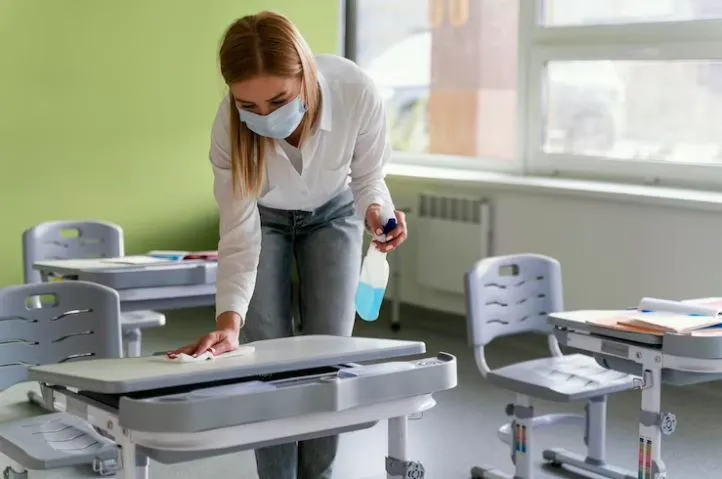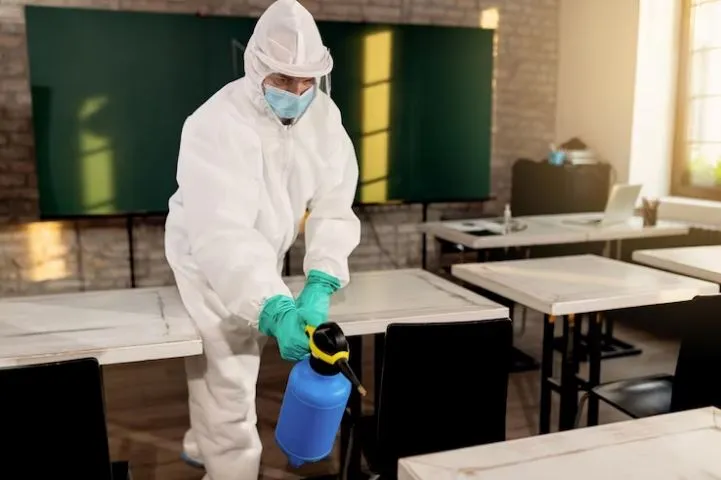Institutions hold a special place in society, serving as hubs for education, healthcare, and various professional endeavors. As we step through their doors, we expect an environment that is not only conducive to productivity but also promotes health, safety, and overall well-being. Behind the scenes, the unsung heroes of cleanliness work tirelessly to maintain impeccable standards. In this article, we will embark on a journey exploring the significance of cleaning in institutions, delving into its profound impact on individuals, the institution itself, and the community it serves.

I. A Healthy Environment:
1. Preventing the Spread of Illness:
In institutions such as schools and healthcare facilities, cleaning plays a pivotal role in reducing the transmission of infectious diseases. Imagine a bustling school where students gather, interact, and share communal spaces. Regular disinfection of surfaces, thorough restroom cleaning, and proper waste management are crucial in creating a healthier environment. By minimizing the presence of harmful pathogens, institutions can safeguard the well-being of students, staff, patients, and visitors alike.
2. Enhancing Indoor Air Quality:
Institutions are often bustling with activity, which can lead to a buildup of pollutants, allergens, and volatile organic compounds (VOCs). Dust particles, pollen, and microscopic irritants can linger in the air, potentially causing respiratory issues and discomfort. Thorough cleaning practices, including regular vacuuming, dusting, and air filtration, help maintain optimal indoor air quality. By removing these pollutants, institutions create a fresh and invigorating atmosphere, allowing individuals to breathe easier and focus better.
3. Allaying Allergies and Sensitivities:
Within institutions, there are individuals who may have allergies or sensitivities to common triggers such as dust mites, pollen, or certain cleaning agents. Recognizing and accommodating these needs is essential for fostering an inclusive environment. Institutions that adopt eco-friendly cleaning practices and use hypoallergenic products prioritize the well-being of all occupants. By reducing the presence of allergens and minimizing potential irritants, they ensure that everyone can thrive in a clean and comfortable setting.
II. Boosting Productivity and Performance:
1. Creating a Positive Environment:
A clean and well-organized workspace has a direct impact on productivity and morale. Picture a clutter-free classroom or an orderly office space. Such environments create a sense of calm and efficiency, allowing individuals to focus and perform at their best. When institutions invest in cleanliness, employees and students feel a sense of pride and are more motivated to excel. A tidy and aesthetically pleasing space fosters a positive mindset, sparking creativity and a drive for success.
2. Reducing Absenteeism:
Illness-related absenteeism can disrupt the flow of learning or productivity within institutions. However, maintaining a clean and hygienic environment can help minimize this disruption. By diligently following cleaning protocols, institutions can reduce the presence of pathogens and allergens. Clean surfaces, coupled with proper ventilation, promote healthier surroundings, leading to fewer sick days for employees and students. This, in turn, ensures continuity and maximizes the potential for growth and achievement.
3. Promoting Mental Well-being:
The impact of cleanliness extends beyond physical health. Cluttered or unclean spaces can contribute to stress, anxiety, and a general sense of unease. Imagine a student trying to concentrate in a messy classroom or an employee working in a disorganized office. Institutions that prioritize cleanliness create an atmosphere that promotes mental well-being. By providing a clean, organized, and harmonious environment, institutions allow individuals to feel calm, centered, and more focused on their tasks. This, in turn, supports their overall mental health and nurtures their potential for success.

III. Upholding Reputation and Trust:
1. First Impressions Matter:
Institutions are often judged by their outward appearance. A clean and well-maintained facility creates a positive first impression on visitors, prospective students, patients, and stakeholders. The cleanliness of the premises reflects the institution’s commitment to professionalism, excellence, and attention to detail. A pristine entryway, spotless corridors, and immaculate common areas convey a sense of pride and create a welcoming atmosphere, instantly instilling confidence in those who interact with the institution.
2. Building Trust and Confidence:
Institutions that prioritize cleanliness instill a sense of trust in their stakeholders. Parents entrusting their children’s education, patients seeking healthcare, or clients collaborating on professional endeavors all value a clean and hygienic environment. Cleanliness communicates that the institution values the well-being of its constituents. It demonstrates a commitment to maintaining high standards, ensuring safety, and providing a conducive environment for growth and success. This trust builds strong relationships and fosters a sense of loyalty and confidence in the institution’s abilities.
IV. Ensuring Safety and Compliance:
1. Mitigating Hazards:
Institutions are bound by safety regulations and protocols. A safe environment is not only a legal requirement but also crucial for the well-being of everyone within the institution. Regular cleaning practices play a crucial role in identifying and mitigating potential hazards. Slippery floors, cluttered pathways, or faulty electrical equipment can pose risks to individuals. By promptly addressing these issues through thorough cleaning and maintenance, institutions can ensure the safety and security of all occupants.
2. Compliance with Health Standards:
Healthcare facilities and food service areas have a responsibility to adhere to stringent health standards. Cleanliness is of utmost importance in these settings to prevent the spread of infections and maintain public health. Regular cleaning, sterilization of medical equipment, and thorough sanitization of food preparation areas are essential for compliance. By adhering to these rigorous standards, institutions contribute to the overall safety and well-being of the community they serve.

V. Environmental Stewardship:
1. Sustainable Practices:
Institutions have the opportunity to lead by example in adopting eco-friendly cleaning practices. By using environmentally friendly cleaning agents, promoting recycling initiatives, and minimizing water and energy consumption, institutions reduce their carbon footprint. Such sustainable practices not only contribute to a healthier environment but also educate and inspire the community. Institutions can play a vital role in raising awareness about the importance of environmental stewardship and instilling a sense of responsibility in their students and employees.
2. Teaching Responsibility:
Educational institutions have a unique opportunity to teach students about their responsibility towards the environment. By incorporating cleaning and sustainability practices into the curriculum, institutions empower students to become environmentally conscious individuals. Teaching the importance of cleanliness, recycling, and sustainable living not only benefits the immediate environment but also equips students with lifelong skills that they can carry into their future endeavors. By instilling a sense of responsibility and accountability, institutions contribute to shaping environmentally conscious citizens.
VI. Sustaining Cleanliness: Best Practices and Professional Assistance
1. Implement Daily Cleaning Protocols:
Instituting daily cleaning protocols is essential to maintain cleanliness in institutions. Develop a comprehensive cleaning schedule that covers all areas, including classrooms, offices, restrooms, and common spaces. Clearly outline tasks, responsibilities, and frequency of cleaning for each area. Regular cleaning routines ensure that cleanliness becomes a consistent habit within the institution.
2. Train and Educate Staff:
Proper training and education are vital for maintaining cleanliness standards. Educate staff members on the importance of cleaning, best practices, and the proper use of cleaning agents and equipment. Emphasize the significance of attention to detail and consistency in maintaining a clean environment. By empowering staff with knowledge and skills, they become active participants in upholding cleanliness within the institution.
3. Provide Adequate Cleaning Supplies:
Ensure that cleaning staff and employees have access to an adequate supply of cleaning products and equipment. Stock up on environmentally friendly cleaning agents, microfiber cloths, mops, brooms, and vacuum cleaners. By providing the necessary tools, institutions enable effective cleaning and contribute to the overall cleanliness and hygiene of the premises.
4. Encourage Personal Responsibility:
Foster a culture of personal responsibility and cleanliness among students, employees, and visitors. Promote the importance of individual actions, such as properly disposing of waste, cleaning up after oneself, and maintaining personal hygiene. By instilling a sense of personal responsibility, institutions create an environment where everyone actively contributes to cleanliness.
5. Establish Clear Guidelines for Waste Management:
Proper waste management is crucial for maintaining cleanliness and hygiene. Install clearly marked bins for different types of waste, such as recyclables, general waste, and organic waste. Regularly empty and clean waste bins to prevent odors and infestations. Educate the community about the importance of responsible waste disposal and recycling practices.
6. Enforce Cleaning Etiquette:
Establish cleaning etiquette guidelines to encourage cleanliness in shared spaces. Encourage individuals to clean up after using common areas, such as kitchens or breakrooms. Promote the habit of wiping down surfaces, washing dishes, and maintaining tidiness. By fostering a culture of shared responsibility, institutions create a clean and harmonious environment for all.
7. Consider Hiring Professional Cleaning Services:
To ensure a consistently high level of cleanliness, institutions can opt to hire professional cleaning services. Professional cleaners bring expertise, specialized equipment, and experience to maintain impeccable cleanliness standards. They can develop customized cleaning plans tailored to the specific needs of the institution. Outsourcing cleaning services allows institutions to focus on their core activities while ensuring a clean and healthy environment.
8. Regular Inspections and Audits:
Conduct regular inspections and audits to evaluate the effectiveness of cleaning practices within the institution. Set up a system for feedback and reporting on cleanliness issues. Address any areas of improvement promptly and provide necessary support and resources to the cleaning staff. Regular monitoring ensures that cleanliness is maintained and continually improved.
9. Promote a Clean and Healthy Lifestyle:
Educate the community about the correlation between cleanliness and overall well-being. Organize workshops, seminars, or awareness campaigns on the importance of cleanliness, hygiene, and healthy habits. Engage students, employees, and visitors in discussions on cleanliness-related topics, fostering a collective understanding and commitment to maintaining a clean environment.
10. Continuous Improvement: Embrace a culture of continuous improvement in cleanliness practices. Stay updated on new cleaning technologies, eco-friendly products, and innovative approaches to cleanliness. Encourage feedback from the community and actively seek suggestions for enhancing cleanliness standards. By constantly striving for improvement, institutions can create an environment that exemplifies cleanliness and sets the benchmark for others.

Conclusion:
Maintaining cleanliness in institutions is a multifaceted endeavor that requires dedication, commitment, and a comprehensive approach. By implementing daily cleaning protocols, providing adequate resources, and fostering a culture of personal responsibility, institutions can uphold cleanliness standards. Considering the option of hiring professional cleaning services ensures consistent cleanliness and frees up time for the institution to focus on its core activities. Through continuous improvement, education, and promoting a clean and healthy lifestyle, institutions can create environments that inspire excellence, nurture well-being, and foster a sense of pride within the community they serve. Cleanliness in institutions is not just a matter of aesthetics but a reflection of their commitment to creating a conducive and thriving environment for all.

